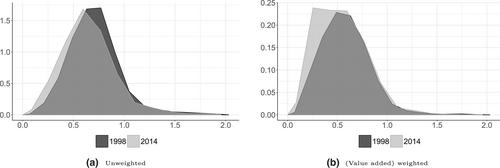企业异质性和总劳动份额
IF 0.5
Q4 INDUSTRIAL RELATIONS & LABOR
引用次数: 0
摘要
我们根据全要素生产率、市场力量、工资和价格联合分布的第一矩,提出了一种基于模型的总劳动份额分解方法,并利用 1998-2014 年的企业级数据将其应用于英国制造业。与关注企业间差距扩大的观点相反,在此期间观察到的总劳动份额下降完全是由代表性企业劳动份额的下降驱动的,这主要是由于平均生产率与实际工资之间的脱节日益严重。企业层面变量分散度的变化略微抑制了这种下降。本文章由计算机程序翻译,如有差异,请以英文原文为准。

Firm heterogeneity and the aggregate labour share
We propose a model-based decomposition method for the aggregate labour share in terms of the first moments of the joint distribution of total factor productivity, market power, wages and prices, and apply it to UK manufacturing using firm-level data for 1998–2014. Contrary to a narrative focussing on increasing disparities between firms, the observed decline in the aggregate labour share over the period is driven entirely by the decline in the labour share of the representative firm, mostly due to an increasing disconnect between average productivity and real wages. Changes in the dispersion of firm-level variables have contributed to slightly contain this decline.
求助全文
通过发布文献求助,成功后即可免费获取论文全文。
去求助
来源期刊

Labour-England
INDUSTRIAL RELATIONS & LABOR-
CiteScore
1.30
自引率
16.70%
发文量
25
期刊介绍:
LABOUR provides a forum for analysis and debate on issues concerning labour economics and industrial relations. The Journal publishes high quality contributions which combine economic theory and statistical methodology in order to analyse behaviour, institutions and policies relevant to the labour market.
 求助内容:
求助内容: 应助结果提醒方式:
应助结果提醒方式:


